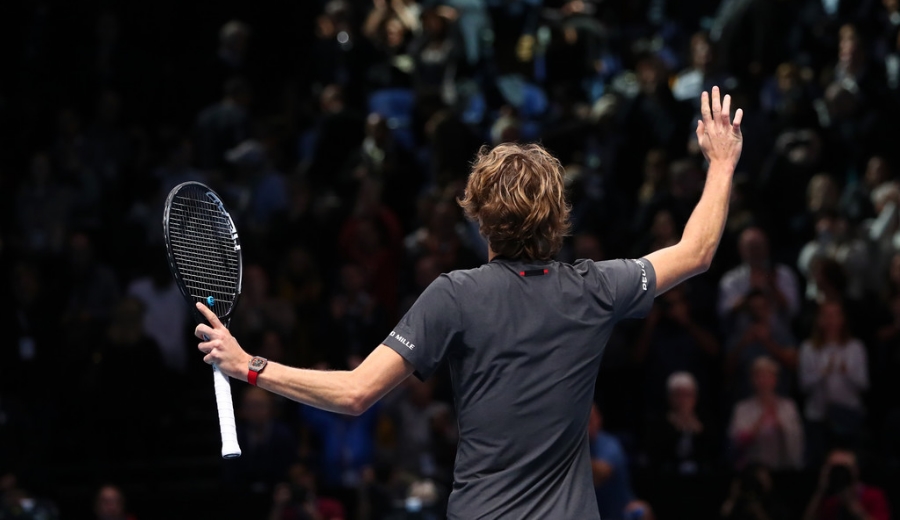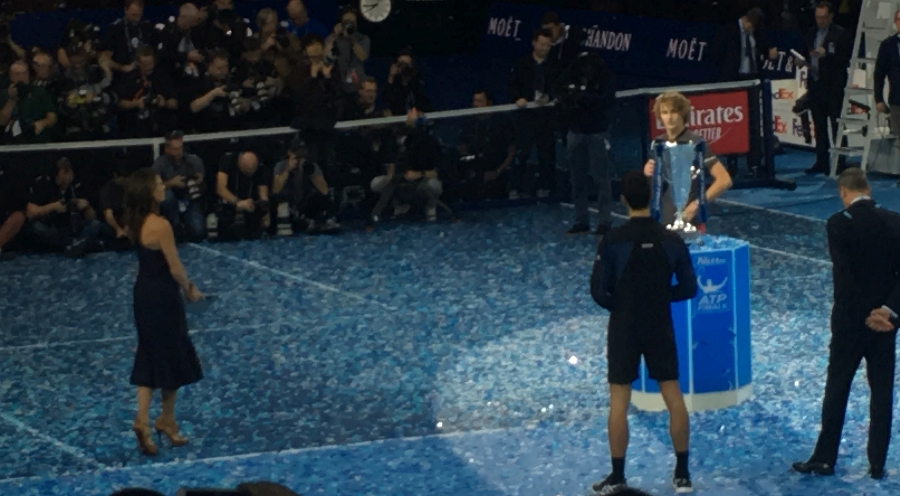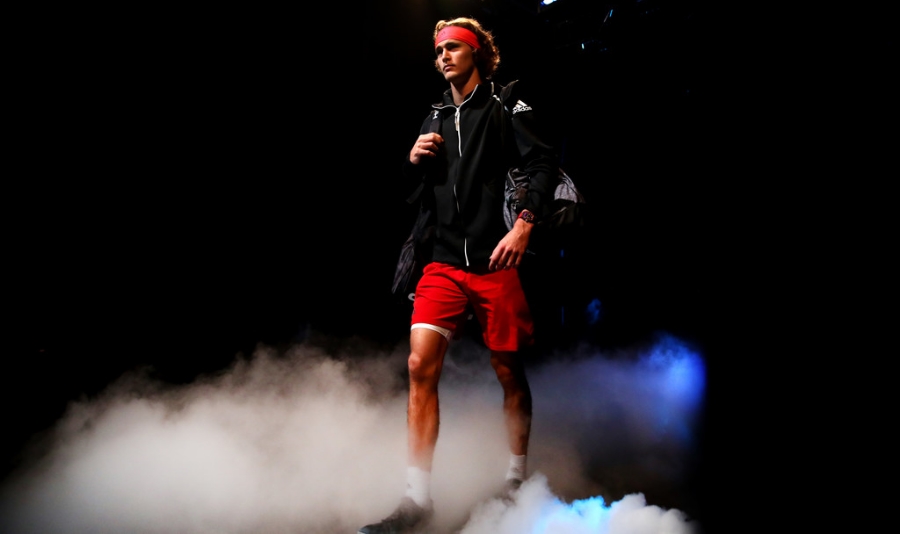On Sunday, Alexander “Sascha” Zverev outplayed the world number one Novak Djokovic in pretty much all aspects of the game and grabbed the title at the ATP Finals in London, the biggest one of the German’s career, with a 6-4 6-3 win in one hour and 20 minutes.
For a moment, I considered using, for this article, the title of my post-match analysis of Zverev’s win over Federer in the semifinals from yesterday and adding “Part II” to the end. Initially, it made sense and neatly reflected the rare feat accomplished by Sascha. This title made him the first player to defeat Federer and Djokovic (who won this tournament a combined 11 times in the last 16 years) in the same ATP Finals, as well as the first player to defeat the no.1 and 2 seeds back to back to lift the trophy since Andre Agassi did it in 1990 (source: ATP Media Info).
Then, I remembered my own insertion in yesterday’s piece that regardless of what happened in the finals, Sascha’s win over Roger was a giant step for the German that stood on its own.
And so does Sunday’s win over Novak Djokovic in the finals.
The two accomplishments should not be packaged into the same giant step as parts one and two. It is one thing to earn the biggest win of your career up to that point, and it is another to back it up the very next day with another convincing win over the number-one player in the world that propels you to your biggest title ever.

While Zverev’s serves, returns, and footwork may have played substantial roles in successfully countering the challenges thrown his way by Djokovic, it was ultimately the 21-year-old German’s astute baseline-pattern tactics that decisively swung the pendulum in his favor.
I believe most tennis fans will agree with me that Zverev’s most valuable (and reliable) stroke has been his backhand. In fact, I have long contended that he can out-duel any player in a backhand-to-backhand rally, whether that would be a cross-court one against a right-hander or a down-the-line one against a left-hander. And I am convinced that Sascha himself believes that he can go toe-to-toe with anyone in this particular pattern.
Would it not then behoove him to find ways to engage his opponents in such rallies, daring them to outperform him even if they possessed one of the best backhands in the world?
Such was the case against Djokovic, and Sascha came out on top in this department. In my opinion, this was the aspect that derailed the wheels of the Djokovic train and led him to a diminished performance in the second set, along with physical fatigue that slowly began to take over – that, in itself, stemming partially from mental fatigue as a result of running out of answers. In the first set, as Darren Cahill also correctly affirmed on TV, Sascha defeated a very good Novak “fair and square,” and backhand cross-court duels played a paramount role in not only that, but also in Zverev getting the decisive break in the second set.
I was interested in who would win the battle of the backhands. I believed that it was one of the only ways (not a guarantee) that Zverev could weather the storm brought on by Djokovic’s ground strokes. It was also something that I had seen in the past, someone using a similar pattern to defeat Djokovic. It took place in Roland Garros, back in 2015, when Stan Wawrinka pulled one of the best baseline-power performances I have ever witnessed on clay courts and took out Djokovic in four sets. In fact, members of Stan’s coaching team confirmed weeks later that engaging in cross-court rallies from the backhand wing was part of his strategy because it would allow Stan to occasionally accelerate down-the-line for the winner to the open court. But what interested me more was the outcome of those rallies where neither Novak nor Sascha would change the pattern.
Thus, I counted the outcome of all rallies in which Zverev and Djokovic got involved in at least four backhand cross-court shots struck in succession (in other words, two shots each). Four shots in a row was a clear indication to me that the two players were fully engaged in a cross-court backhand rally. Djokovic and Zverev played 16 such points until 4-2 in the second set. Sascha won that battle 11-5 over Novak.
Note: My numbers may be off by one, at the most two, as I was briefly interrupted from watching twice and missed a few points.
Then, I wanted to see how many of these points ended in Sascha’s or Novak’s favor when one or the other decided to change the pattern by hitting down-the-line or a drop shot. I found out that when they did, it did not necessarily benefit them. Novak was 1/4 on those, and Zverev did not fare much better at 2/5.
And what about when neither player changed the pattern, and instead, dared each other to miss first or nail the direct winner? This is where Zverev held an overwhelming 7-1 lead!
The only point won by Novak was the last point of the 2-2 game in the first set, when both players attempted to out-slice each other. It ended with Zverev hitting his into the net. But otherwise, he held a clear advantage over Novak in what is otherwise presumed to be an advantageous area for the Serbian player. It is, after all, rare that Novak is unable to out-duel his opponent on backhands. But even if that were to occur, Novak can still use his backhand down-the-line acceleration, another one of his super assets. Well, they were not enough this time to turn the tide in his favor due to above numbers, and also partially due to Zverev having a fantastic day on his forehand. He continuously landed his forehands deep, using a healthy mix of heavy topspin shots and flat swipes.
It also helped that Sascha served 88% of his first serves in – an extraordinary number for a “bazooka” first serve like his – which led to seven aces and a bunch of opportunities for Sascha to take charge on the follow-up shot. Last but not the least, and I can say this for both of his wins over the weekend, I did not see Zverev’s body language turn distinctively sour, which he has done in the past. Even after points lost on strategic mistakes or disappointing errors, I did not at any point observe Sascha “whine” extensively. He may have shaken his head, or glanced at his corner in dismay, but he moved on within seconds and got ready for the next shot. He was a mental rock throughout four sets over two days.
I must again reiterate that none of the tactic-related or stat-related elements that I mention in the last paragraph above would be enough (or even possible) if Sascha had not gained the upper hand in the baseline battles first. In establishing a dominance on the backhand-to-backhand duels, Zverev was able to kill two birds with one stone; negating one of Novak’s most reliable assets by maximizing the return on his own favorite asset.
If you are a Sascha fan, there is a lot to celebrate here. The lack of Major titles still remains in effect, but this weekend should serve to practically make the “if” question disappear to the point where the “when” question is now the only one nagging your mind. In any case, that concern can be swept under the rug until January at least. For now, enjoy the title that your player thoroughly deserved by passing one of the toughest tests in contemporary men’s tennis with flying colors.


